Effect of Solubilizing Group on the Antibacterial Activity of Heptamethine Cyanine Photosensitizers
Abstract
1. Introduction
2. Materials and Methods
2.1. General
2.2. Synthesis
2.3. Absorption and Fluorescence Measurements
2.4. Quantum Yield of Singlet Oxygen Generation
2.5. Dye Uptake by Cells
2.6. Antimicrobial Studies
3. Results and Discussion
3.1. Overview of the Dye Structures
3.2. Synthesis
3.3. Spectral Properties and Quantum Yields of Singlet Oxygen Generation
3.4. Dye Uptake by Bacteria
3.5. Toxicity and Phototoxicity of the Dyes
3.5.1. Photodynamic Eradication of S. aureus
3.5.2. Photodynamic Eradication of E. coli and P. aeruginosa
3.5.3. Phototoxicity of the Dyes vs. the Quantum Yield of the Singlet Oxygen Generation and the Uptake by Bacteria
4. Conclusions
Supplementary Materials
Author Contributions
Funding
Institutional Review Board Statement
Informed Consent Statement
Data Availability Statement
Acknowledgments
Conflicts of Interest
References
- Correia, J.H.; Rodrigues, J.A.; Pimenta, S.; Dong, T.; Yang, Z. Photodynamic therapy review: Principles, photosensitizers, applications, and future directions. Pharmaceutics 2021, 13, 1332. [Google Scholar] [CrossRef] [PubMed]
- Cieplik, F.; Deng, D.; Crielaard, W.; Buchalla, W.; Hellwig, E.; Al-Ahmad, A.; Maisch, T. Antimicrobial photodynamic therapy—What we know and what we don’t. Crit. Rev. Microbiol. 2018, 44, 571–589. [Google Scholar] [CrossRef] [PubMed]
- Gunaydin, G.; Gedik, M.E.; Ayan, S. Photodynamic therapy for the treatment and diagnosis of cancer—A review of the current clinical status. Front. Chem. 2021, 9, 1–26. [Google Scholar] [CrossRef]
- Algorri, J.F.; Ochoa, M.; Roldán-Varona, P.; Rodríguez-Cobo, L.; López-Higuera, J.M. Photodynamic therapy: A compendium of latest reviews. Cancers 2021, 13, 4447. [Google Scholar] [CrossRef] [PubMed]
- Wang, K.; Yu, B.; Pathak, J.L. An update in clinical utilization of photodynamic therapy for lung cancer. J. Cancer 2021, 12, 1154–1160. [Google Scholar] [CrossRef]
- Songca, S.P.; Adjei, Y. Applications of antimicrobial photodynamic therapy against bacterial biofilms. Int. J. Mol. Sci. 2022, 23, 3209. [Google Scholar] [CrossRef]
- Dias, L.D.; Blanco, K.C.; Bagnato, V.S. COVID-19: Beyond the virus. The use of photodynamic therapy for the treatment of infections in the respiratory tract. Photodiagnosis Photodyn. Ther. 2020, 31, 101804. [Google Scholar] [CrossRef]
- Hung, J.-H.; Lee, C.-N.; Hsu, H.-W.; Ng, I.-S.; Wu, C.-J.; Yu, C.-K.; Lee, N.-Y.; Chang, Y.; Wong, T.-W. Recent advances in photodynamic therapy against fungal keratitis. Pharmaceutics 2021, 13, 2011. [Google Scholar] [CrossRef]
- Li, L.; Chen, Y.; Chen, W.; Tan, Y.; Chen, H.; Yin, J. Photodynamic therapy based on organic small molecular fluorescent dyes. Chin. Chem. Lett. 2019, 30, 1689–1703. [Google Scholar] [CrossRef]
- Shang, L.; Zhou, X.; Zhang, J.; Shi, Y.; Zhong, L. Metal nanoparticles for photodynamic therapy: A potential treatment for breast cancer. Molecules 2021, 26, 6532. [Google Scholar] [CrossRef]
- Nasseri, B.; Alizadeh, E.; Bani, F.; Davaran, S.; Akbarzadeh, A.; Rabiee, N.; Bahadori, A.; Ziaei, M.; Bagherzadeh, M.; Saeb, M.R.; et al. Nanomaterials for photothermal and photodynamic cancer therapy. Appl. Phys. Rev. 2022, 9, 011317. [Google Scholar] [CrossRef]
- Zhao, X.; Liu, J.; Fan, J.; Chao, H.; Peng, X. Recent progress in photosensitizers for overcoming the challenges of photodynamic therapy: From molecular design to application. Chem. Soc. Rev. 2021, 50, 4185–4219. [Google Scholar] [CrossRef]
- Kou, J.; Dou, D.; Yang, L. Porphyrin photosensitizers in photodynamic therapy and its applications. Oncotarget 2017, 8, 81591–81603. [Google Scholar] [CrossRef] [PubMed]
- Srivatsan, A.; Missert, J.R.; Upadhyay, S.K.; Pandey, R.K. Porphyrin-based photosensitizers and the corresponding multifunctional nanoplatforms for cancer-imaging and phototherapy. J. Porphyr. Phthalocyanines 2015, 19, 109–134. [Google Scholar] [CrossRef]
- Zheng, B.-D.; Ye, J.; Zhang, X.-Q.; Zhang, N.; Xiao, M.-T. Recent advances in supramolecular activatable phthalocyanine-based photosensitizers for anti-cancer therapy. Coord. Chem. Rev. 2021, 447, 214155. [Google Scholar] [CrossRef]
- Chen, D.; Song, M.; Huang, J.; Chen, N.; Xue, J.; Huang, M. Photocyanine: A novel and effective phthalocyanine-based photosensitizer for cancer treatment. J. Innov. Opt. Health Sci. 2020, 13, 2030009. [Google Scholar] [CrossRef]
- Li, X.; Zheng, B.-D.; Peng, X.-H.; Li, S.-Z.; Ying, J.-W.; Zhao, Y.; Huang, J.-D.; Yoon, J. Phthalocyanines as medicinal photosensitizers: Developments in the last five years. Coord. Chem. Rev. 2019, 379, 147–160. [Google Scholar] [CrossRef]
- Bilici, K.; Cetin, S.; Aydındogan, E.; Yagci Acar, H.; Kolemen, S. Recent advances in cyanine-based phototherapy agents. Front. Chem. 2021, 9, 1–15. [Google Scholar] [CrossRef]
- Lange, N.; Szlasa, W.; Saczko, J.; Chwiłkowska, A. Potential of cyanine derived dyes in photodynamic therapy. Pharmaceutics 2021, 13, 818. [Google Scholar] [CrossRef]
- Dereje, D.M.; Pontremoli, C.; Plata, M.J.M.; Visentin, S.; Barbero, N. Polymethine dyes for PDT: Recent advances and perspectives to drive future applications. Photochem. Photobiol. Sci. 2022, 21, 397–419. [Google Scholar] [CrossRef]
- Ogawa, M.; Kosaka, N.; Choyke, P.L.; Kobayashi, H. In vivo molecular imaging of cancer with a quenching near-infrared fluorescent probe using conjugates of monoclonal antibodies and Indocyanine Green. Cancer Res. 2009, 69, 1268–1272. [Google Scholar] [CrossRef]
- Shafirstein, G.; Bäumler, W.; Hennings, L.J.; Siegel, E.R.; Friedman, R.; Moreno, M.A.; Webber, J.; Jackson, C.; Griffin, R.J. Indocyanine Green enhanced near-infrared laser treatment of murine mammary carcinoma. Int. J. Cancer 2012, 130, 1208–1215. [Google Scholar] [CrossRef]
- Cao, J.; Chi, J.; Xia, J.; Zhang, Y.; Han, S.; Sun, Y. Iodinated cyanine dyes for fast near-infrared-guided deep tissue synergistic phototherapy. ACS Appl. Mater. Interfaces 2019, 11, 25720–25729. [Google Scholar] [CrossRef] [PubMed]
- Bokan, M.; Nakonechny, F.; Talalai, E.; Kobzev, D.; Gellerman, G.; Patsenker, L. Photodynamic effect of novel hexa-iodinated quinono-cyanine dye on staphylococcus aureus. Photodiagnosis Photodyn. Ther. 2020, 31, 101866. [Google Scholar] [CrossRef]
- Atchison, J.; Kamila, S.; Nesbitt, H.; Logan, K.A.; Nicholas, D.M.; Fowley, C.; Davis, J.; Callan, B.; McHale, A.P.; Callan, J.F. Iodinated cyanine dyes: A new class of sensitisers for use in NIR activated photodynamic therapy (PDT). Chem. Commun. 2017, 53, 2009–2012. [Google Scholar] [CrossRef] [PubMed]
- Wang, Z.; Ivanov, M.; Gao, Y.; Bussotti, L.; Foggi, P.; Zhang, H.; Russo, N.; Dick, B.; Zhao, J.; Di Donato, M.; et al. Spin–orbit charge-transfer intersystem crossing (ISC) in compact electron donor–acceptor dyads: ISC mechanism and application as novel and potent photodynamic therapy reagents. Chem.—A Eur. J. 2020, 26, 1091–1102. [Google Scholar] [CrossRef] [PubMed]
- Ebaston, T.M.; Nakonechny, F.; Talalai, E.; Gellerman, G.; Patsenker, L. Iodinated xanthene-cyanine NIR dyes as potential photosensitizers for antimicrobial photodynamic therapy. Dyes Pigm. 2021, 184, 108854. [Google Scholar] [CrossRef]
- Dong, Y.; Zhou, L.; Shen, Z.; Ma, Q.; Zhao, Y.; Sun, Y.; Cao, J. Iodinated cyanine dye-based nanosystem for synergistic phototherapy and hypoxia-activated bioreductive therapy. Drug Deliv. 2022, 29, 238–253. [Google Scholar] [CrossRef]
- Liu, H.; Yin, J.; Xing, E.; Du, Y.; Su, Y.; Feng, Y.; Meng, S. Halogenated cyanine dyes for synergistic photodynamic and photothermal therapy. Dyes Pigm. 2021, 190, 109327. [Google Scholar] [CrossRef]
- Kopke, T.; Zaleski, J. Diazo-containing molecular constructs as potential anticancer agents: From diazo[b]fluorene natural products to photoactivatable diazo-oxochlorins. Anticancer Agents Med. Chem. 2008, 8, 292–304. [Google Scholar] [CrossRef]
- Chen, J.; Chen, Z.; Tan, L.; Yang, J.; Shen, L.; Deng, J.; Jiang, X.; Zou, D. Synthesis of a new chlorin photosensitizer for photodynamic therapy against colon cancer. Mater. Chem. Front. 2022, 6, 1129–1136. [Google Scholar] [CrossRef]
- Semenova, O.; Kobzev, D.; Yazbak, F.; Nakonechny, F.; Kolosova, O.; Tatarets, A.; Gellerman, G.; Patsenker, L. Unexpected effect of iodine atoms in heptamethine cyanine dyes on the photodynamic eradication of Gram-positive and Gram-negative pathogens. Dyes Pigm. 2021, 195, 109745. [Google Scholar] [CrossRef]
- Zhang, R.; Qin, X.; Kong, F.; Chen, P.; Pan, G. Improving cellular uptake of therapeutic entities through interaction with components of cell membrane. Drug Deliv. 2019, 26, 328–342. [Google Scholar] [CrossRef] [PubMed]
- Palermo, E.F.; Lee, D.-K.; Ramamoorthy, A.; Kuroda, K. Role of cationic group structure in membrane binding and disruption by amphiphilic copolymers. J. Phys. Chem. B 2011, 115, 366–375. [Google Scholar] [CrossRef] [PubMed]
- Jones, G.W.; Tatarets, A.L.; Patsenker, L.D. Halogenated Compounds for Photodynamic Therapy. U.S. Patent 8,748,446 B2, 10 June 2014. [Google Scholar]
- Jones, G.W.; Tatarets, A.L.; Patsenker, L.D. Halogenated Compounds for Photodynamic Therapy. U.S. Patent 8,962,797 B2, 24 February 2015. [Google Scholar]
- Markova, L.I.; Fedyunyayeva, I.A.; Povrozin, Y.A.; Semenova, O.M.; Khabuseva, S.U.; Terpetschnig, E.A.; Patsenker, L.D. Water soluble indodicarbocyanine dyes based on 2,3-dimethyl-3-(4-sulfobutyl)-3H-indole-5-sulfonic acid. Dyes Pigm. 2013, 96, 535–546. [Google Scholar] [CrossRef]
- Saha, P.C.; Chatterjee, T.; Pattanayak, R.; Das, R.S.; Mukherjee, A.; Bhattacharyya, M.; Guha, S. Targeting and imaging of mitochondria using near-infrared cyanine dye and its application to multicolor imaging. ACS Omega 2019, 4, 14579–14588. [Google Scholar] [CrossRef]
- Sato, K.; Gorka, A.P.; Nagaya, T.; Michie, M.S.; Nakamura, Y.; Nani, R.R.; Coble, V.L.; Vasalatiy, O.V.; Swenson, R.E.; Choyke, P.L.; et al. Effect of charge localization on the in vivo optical imaging properties of near-infrared cyanine dye/monoclonal antibody conjugates. Mol. Biosyst. 2016, 12, 3046–3056. [Google Scholar] [CrossRef]
- Texier, I.; Goutayer, M.; Da Silva, A.; Guyon, L.; Djaker, N.; Josserand, V.; Neumann, E.; Bibette, J.; Vinet, F. Cyanine-loaded lipid nanoparticles for improved in vivo fluorescence imaging. J. Biomed. Opt. 2009, 14, 054005. [Google Scholar] [CrossRef]
- Parker, C.A. Photoluminescence of Solutions; Elsevier Publishing Co.: Amsterdam, The Netherlands, 1968; p. 544. [Google Scholar]
- Štacková, L.; Muchová, E.; Russo, M.; Slavíček, P.; Štacko, P.; Klán, P. Deciphering the structure–property relations in substituted heptamethine cyanines. J. Org. Chem. 2020, 85, 9776–9790. [Google Scholar] [CrossRef]
- Lin, H.; Shen, Y.; Chen, D.; Lin, L.; Wilson, B.C.; Li, B.; Xie, S. Feasibility study on quantitative measurements of singlet oxygen generation using Singlet Oxygen Sensor Green. J. Fluoresc. 2013, 23, 41–47. [Google Scholar] [CrossRef]
- ThermoFisher Scientific. Available online: https://www.thermofisher.com/document-connect/document-connect.html?url=https://assets.thermofisher.com/TFS-Assets%2FLSG%2Fmanuals%2Fmp36002.pdf (accessed on 29 October 2022).
- Wang, S.; Shang, L.; Li, L.; Yu, Y.; Chi, C.; Wang, K.; Zhang, J.; Shi, R.; Shen, H.; Waterhouse, G.I.N.; et al. Metal-organic-framework-derived mesoporous carbon nanospheres containing porphyrin-like metal centers for conformal phototherapy. Adv. Mater. 2016, 28, 8379–8387. [Google Scholar] [CrossRef] [PubMed]
- Reddi, B.A. Why is saline so acidic (and does it really matter?). Int. J. Med. Sci. 2013, 10, 747–750. [Google Scholar] [CrossRef] [PubMed]
- Riddick, J.A.; Bunger, W.B.; Sakano, T.K. Techniques of Chemistry, Vol II. In Organic Solvents. Physical Properties and Methods of Purification, 4th ed.; John Wiley and Sons: New York, NY, USA, 1986. [Google Scholar]
- Guthrie, J.P. Hydrolysis of esters of oxy acids: pKa values for strong acids; Brønsted relationship for attack of water at methyl; free energies of hydrolysis of esters of oxy acids; and a linear relationship between free energy of hydrolysis and pKa holding over a ran. Can. J. Chem. 1978, 56, 2342–2354. [Google Scholar] [CrossRef]

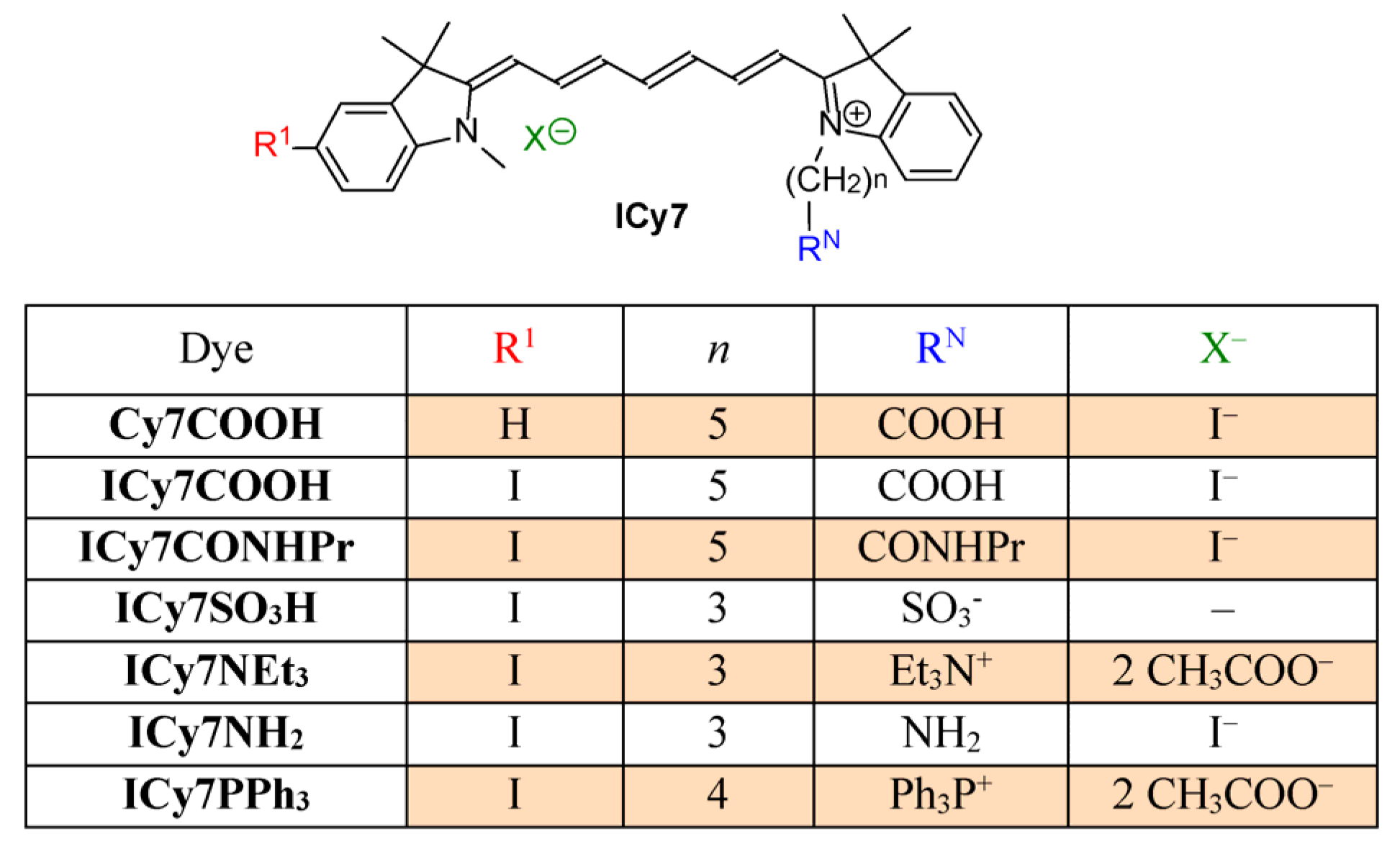


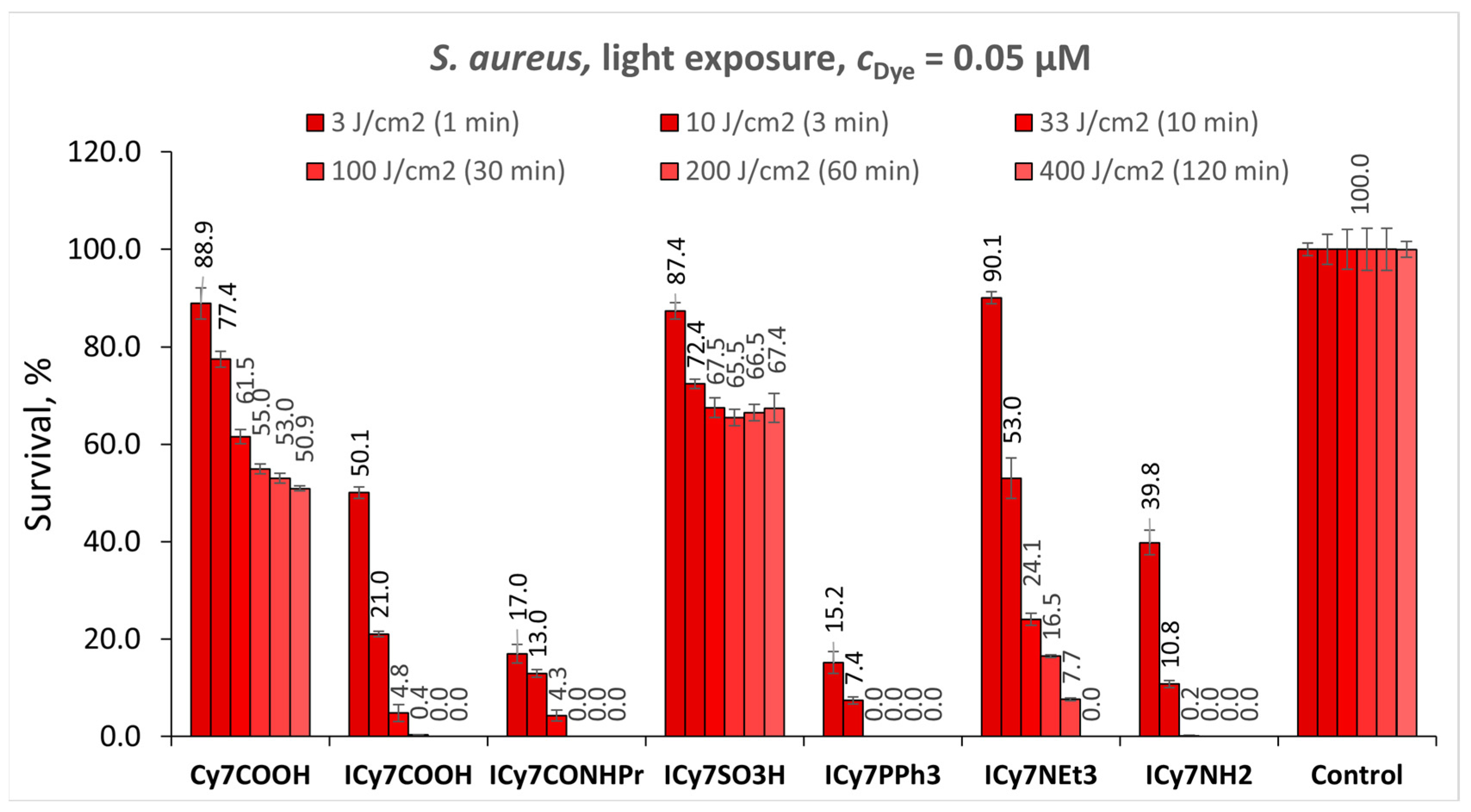
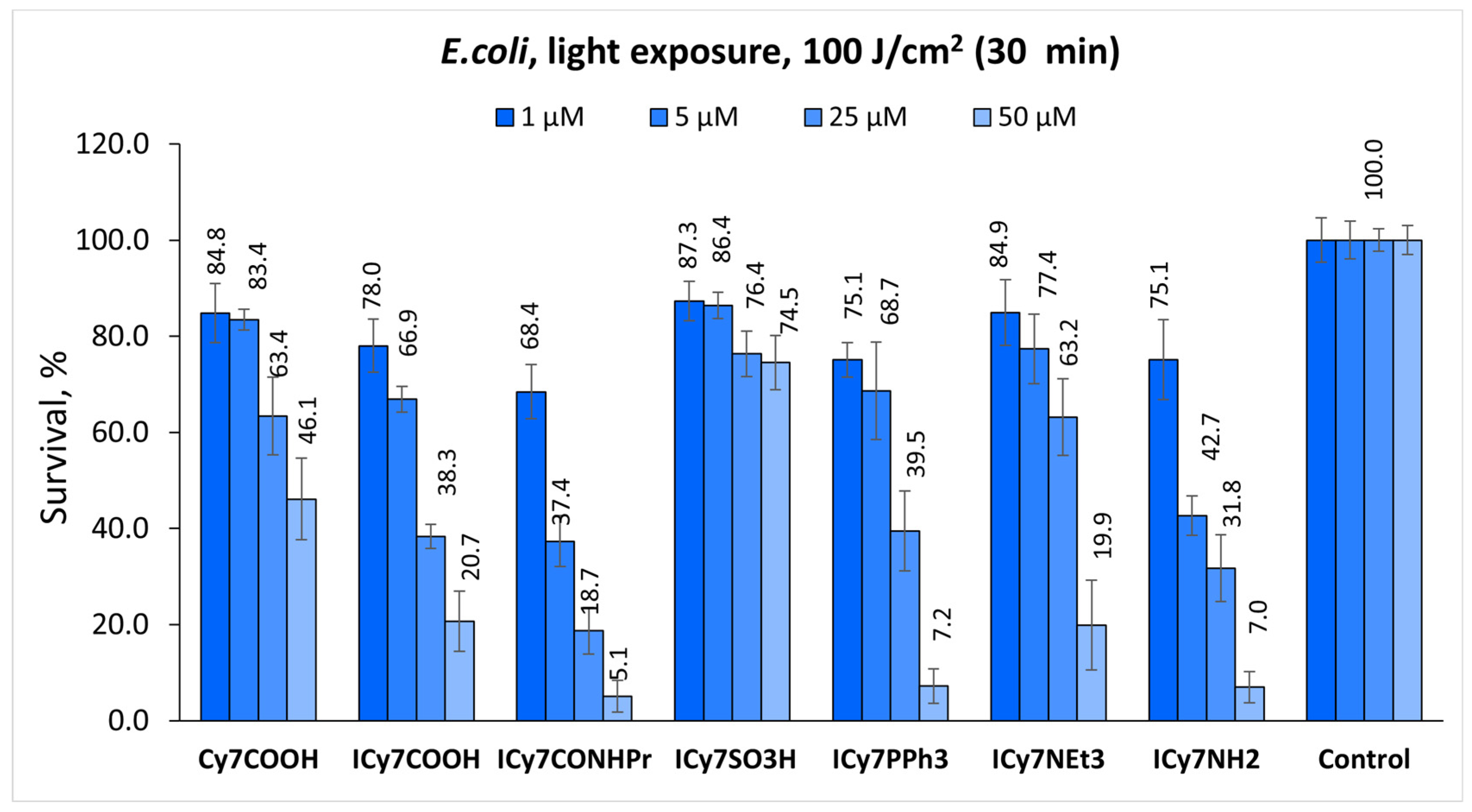
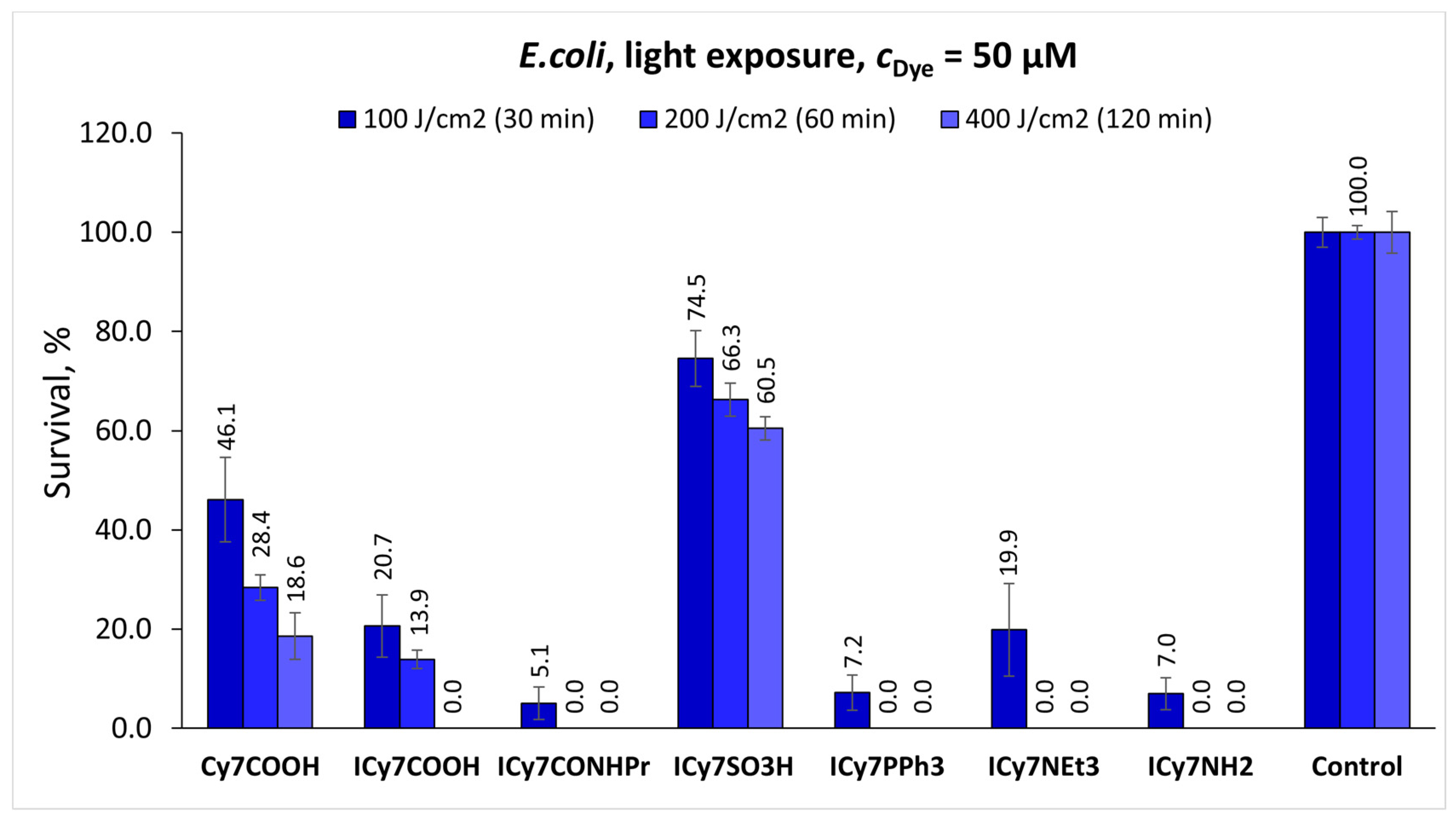



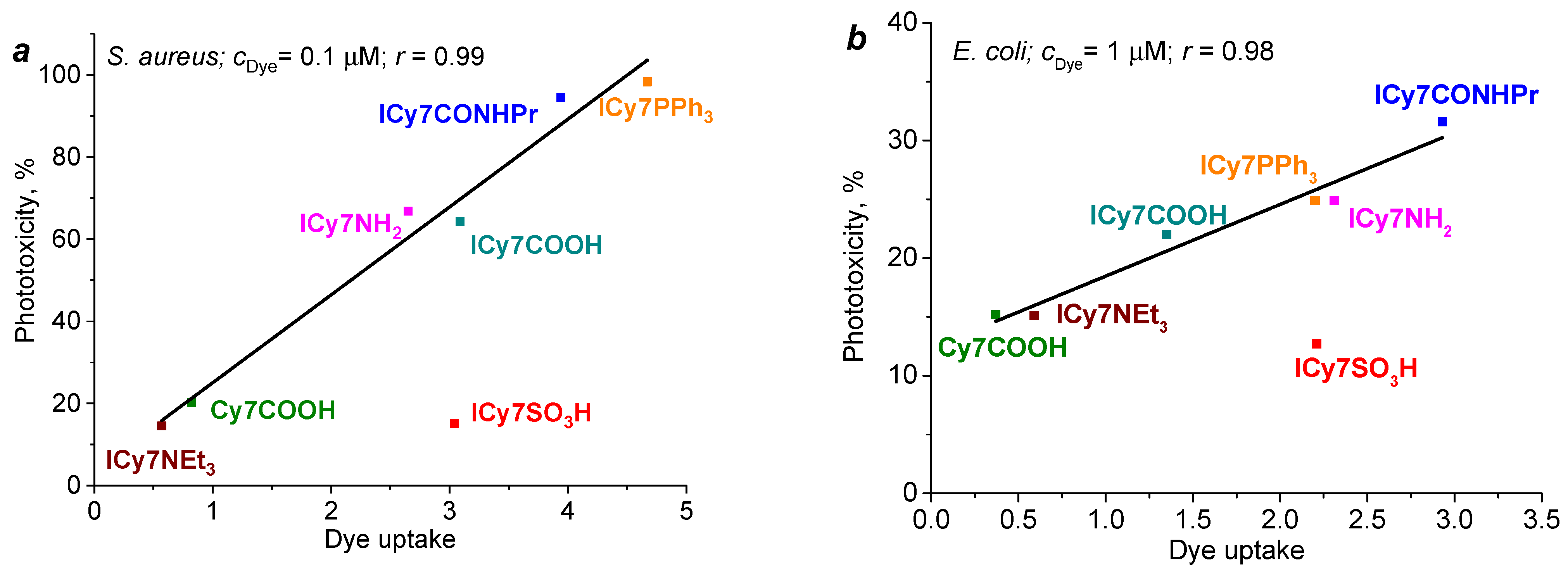
| Dye Structure | MeOH | 0.7% DMSO in Saline | ||||||||
|---|---|---|---|---|---|---|---|---|---|---|
| λmaxAb, nm | ε M−1cm−1 | λmaxFl, nm | ΦF 1, % | ΦΔ 2, % | λmaxAb, nm | ε, M−1cm−1 | λmaxFl, nm | ΦF 1, % | ΦΔ 3, % | |
 | 744 | 230,000 | 774 | 25.3 ± 0.5 | 1.1 ± 0.1 | 740 | 169,000 | 768 | 13 ± 1 | 9.5 ± 0.6 |
 | 749 | 230,000 | 780 | 25.8 ± 0.5 | 1.8 ± 0.2 | 747 | 143,000 | 776 | 11 ± 2 | 15 ± 1 |
 | 749 | 215,000 | 784 | 25.4 ± 0.4 | 2.5 ± 0.1 | 747 | 109,000 | 776 | 8 ± 1 | 65 ± 4 |
 | 750 | 230,000 | 781 | 25.5 ± 0.8 | 2.0 ± 0.1 | 747 | 238,000 | 777 | 10 ± 1 | 4.5 ± 0.3 |
 | 751 | 230,000 | 781 | 25.9 ± 0.5 | 2.5 ± 0.2 | 750 | 155,000 | 777 | 9.1 ± 0.8 | 44 ± 3 |
 | 747 | 230,000 | 778 | 24.7 ± 0.7 | 1.7 ± 0.2 | 745 | 176,000 | 775 | 12 ± 1 | 29 ± 1 |
 | 749 | 220,000 | 780 | 24.6 ± 0.6 | 2.9 ± 0.1 | 745 | 187,000 | 775 | 9 ± 1 | 21 ± 2 |
Disclaimer/Publisher’s Note: The statements, opinions and data contained in all publications are solely those of the individual author(s) and contributor(s) and not of MDPI and/or the editor(s). MDPI and/or the editor(s) disclaim responsibility for any injury to people or property resulting from any ideas, methods, instructions or products referred to in the content. |
© 2023 by the authors. Licensee MDPI, Basel, Switzerland. This article is an open access article distributed under the terms and conditions of the Creative Commons Attribution (CC BY) license (https://creativecommons.org/licenses/by/4.0/).
Share and Cite
Semenova, O.; Kobzev, D.; Hovor, I.; Atrash, M.; Nakonechny, F.; Kulyk, O.; Bazylevich, A.; Gellerman, G.; Patsenker, L. Effect of Solubilizing Group on the Antibacterial Activity of Heptamethine Cyanine Photosensitizers. Pharmaceutics 2023, 15, 247. https://doi.org/10.3390/pharmaceutics15010247
Semenova O, Kobzev D, Hovor I, Atrash M, Nakonechny F, Kulyk O, Bazylevich A, Gellerman G, Patsenker L. Effect of Solubilizing Group on the Antibacterial Activity of Heptamethine Cyanine Photosensitizers. Pharmaceutics. 2023; 15(1):247. https://doi.org/10.3390/pharmaceutics15010247
Chicago/Turabian StyleSemenova, Olga, Dmytro Kobzev, Iryna Hovor, Melad Atrash, Faina Nakonechny, Olesia Kulyk, Andrii Bazylevich, Gary Gellerman, and Leonid Patsenker. 2023. "Effect of Solubilizing Group on the Antibacterial Activity of Heptamethine Cyanine Photosensitizers" Pharmaceutics 15, no. 1: 247. https://doi.org/10.3390/pharmaceutics15010247
APA StyleSemenova, O., Kobzev, D., Hovor, I., Atrash, M., Nakonechny, F., Kulyk, O., Bazylevich, A., Gellerman, G., & Patsenker, L. (2023). Effect of Solubilizing Group on the Antibacterial Activity of Heptamethine Cyanine Photosensitizers. Pharmaceutics, 15(1), 247. https://doi.org/10.3390/pharmaceutics15010247








